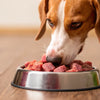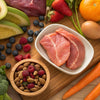Understanding How Much Raw Dog Food to Feed Your Furry Friend
- Houndsy
Table of Contents
- Introduction
- Understanding Raw Dog Food: What Is It and Why Consider It?
- Factors Influencing Feeding Amounts
- Basic Guidelines for Feeding Raw Dog Food
- Calculating the Right Portions for Your Dog
- Tips for Transitioning to a Raw Diet
- The Houndsy Difference: How Our Kibble Dispenser Can Help
- Conclusion
Introduction
Did you know that nearly 40% of dog owners consider switching to a raw food diet for their pets? The excitement surrounding raw dog food diets is palpable, with pet parents claiming remarkable improvements in their dogs' health, energy levels, and coat shine. However, the commitment to providing the right amount of raw food can be a daunting task. How do we determine the precise portion sizes and nutritional balance needed to ensure our furry companions thrive?
This blog post aims to unravel the complexities behind determining how much raw dog food to feed our pets, exploring guidelines, factors affecting dietary needs, and practical tips for transition. By the end of this article, you'll have a comprehensive understanding of how to tailor a raw food diet to fit the unique needs of your dog, making a well-informed decision that enhances their quality of life and aligns with our mission at Houndsy to elevate pet care experiences.
We will cover the following key areas:
- Understanding Raw Dog Food: What Is It and Why Consider It?
- Factors Influencing Feeding Amounts
- Basic Guidelines for Feeding Raw Dog Food
- Calculating the Right Portions for Your Dog
- Tips for Transitioning to a Raw Diet
- The Houndsy Difference: How Our Kibble Dispenser Can Help
So, as we journey through this topic, we encourage you to reflect on your current feeding routine. Are you providing the best possible nutrition for your pup? Let’s dive deeper to discover how we can transform your dog’s mealtime together!
Understanding Raw Dog Food: What Is It and Why Consider It?
The raw dog food diet, often referred to as "BARF" (Biologically Appropriate Raw Food or Bones and Raw Food), seeks to mimic a dog's natural ancestral eating habits. Although opinions on the raw food diet vary, many proponents believe that it offers unparalleled nutritional benefits. This diet typically includes a combination of raw meats, bones, organs, and some fruits or vegetables.
Why is this important? Research supports the notion that a diet closely mimicking a dog’s natural consumption can lead to improvements in overall health. For instance:
- Healthier skin and coat.
- Improved digestion and nutrient absorption.
- Increased energy levels and vitality.
- Reduction in food allergies and sensitivities.
However, transitioning to a raw diet requires ensuring that we provide balanced meals. This is where knowing how much raw dog food to serve becomes crucial. We must consider factors such as age, weight, activity level, and health status to ensure our furry companions receive adequate nutrition without overfeeding.
Factors Influencing Feeding Amounts
Feeding raw dog food isn’t a one-size-fits-all approach. Various elements can influence the amount of food your dog requires, and it's essential to consider the following:
1. Weight
Weight is arguably the most significant factor in determining how much food is needed. A general guideline is to feed dogs 2-4% of their ideal body weight each day.
2. Age
Younger dogs, especially puppies, have different nutritional needs than adults. Puppies typically require 4-6% of their body weight per day to support rapid growth and development.
3. Activity Level
An active dog that regularly engages in physical exercise may require more food than a less active or older dog.
4. Health Status
Any underlying health conditions or sensitivities should dictate dietary needs. For instance, a dog with a sensitive stomach may benefit from smaller, more frequent meals, while an otherwise healthy dog may handle larger portions.
5. Breed Considerations
Certain breeds have higher metabolisms or unique dietary needs. Knowing your breed's characteristics can help in estimating food portions more accurately.
In conclusion, evaluating these factors will help us create a tailored feeding plan for our furry friends, linking beautifully back to our mission at Houndsy to advance the dog-feeding experience.
Basic Guidelines for Feeding Raw Dog Food
Transitioning to a raw diet involves understanding basic feeding guidelines, which can simplify the process. Here are some foundational rules to follow when determining how much raw dog food to give:
Adult Dogs
-
Percentage of Body Weight: A general recommendation is to feed 2-3% of an adult dog’s ideal body weight.
- Example: For a 50-pound dog, this translates to 1-1.5 pounds of raw food daily.
Puppies
-
Increased Percentage: Puppies require a higher intake of food based on their rapid growth. Feeding 4-6% of their current weight is typically recommended.
- Example: A 10-pound puppy would need around 0.4-0.6 pounds of food daily.
Senior Dogs
-
Monitor Weight Closely: With senior pets, it’s critical to adjust the food amount based on any changes in weight or activity levels.
-
Quantity Change: Often, feeding at the lower end of the scale (2-3% of their body weight) suffices, ensuring that dietary adjustments focus on maintaining weight.
General Feeding Schedule
Feeding frequency can vary, depending on a dog's age:
- Puppies: 3-4 meals per day.
- Adult Dogs: 1-2 meals per day.
While these guidelines serve as a starting point, continuous observation and adjustments are vital, reminding us of our commitment to pet well-being.
Calculating the Right Portions for Your Dog
Now that we grasp the overview of raw feeding guidelines, it’s time to get into the specifics. Here’s how to calculate the right food portions for your dog!
Step 1: Determine Ideal Body Weight
Before anything else, we must ascertain your dog’s ideal body weight. Consult your vet if you’re uncertain about what that weight should be based on breed, age, and health.
Step 2: Apply the Percentage Guidelines
Once you have the ideal weight, we can calculate food amounts based on the percentage chart of 2-4% for adults and 4-6% for puppies.
Examples
-
For an Adult Dog:
- Ideal Weight: 50 pounds
- Daily Amount (2-3%): 1 to 1.5 pounds of raw food daily
- Feeding Twice Daily: 0.5 to 0.75 pounds per meal
-
For a Puppy:
- Current Weight: 20 pounds
- Daily Amount (4-6%): 0.8 to 1.2 pounds of raw food daily
- Feeding Three Times Daily: Approximately 0.25 to 0.4 pounds per meal
Step 3: Adjust Based on Observations
Monitor your dog’s weight and health status continuously. Look for signs of proper weight maintenance or loss and adjust feeding amounts accordingly.
As you refine your feeding strategy, consider utilizing our Houndsy Kibble Dispenser, designed for convenient portion control. It can simplify your feeding process significantly, ensuring your dog gets the consistently correct amount every meal!
Tips for Transitioning to a Raw Diet
Transitioning to a raw diet can be an exciting journey, but it requires careful planning and implementation. Here are our top tips to ensure a smooth transition for your furry friend:
1. Gradual Introduction
Start by mixing raw food with your dog’s current diet, gradually increasing the raw proportion over several days or weeks. This helps their digestive system adjust smoothly.
2. Monitor Their Tolerance
Watch for any digestive issues or allergies. If your dog shows signs of discomfort (like diarrhea or vomiting), slow down the transition or consult your vet.
3. Maintain Variety
Offer a variety of proteins and ingredients to ensure a well-rounded diet. For instance, rotate between beef, chicken, fish, and even some fruits or vegetables that are safe for dogs.
4. Educate Yourself
Take the time to learn about nutrition and raw feeding to create balanced meals effectively. Understanding the right balance of protein, fats, and carbohydrates can simplify planning your dog’s meals.
5. Consult Your Vet
Whenever making significant dietary changes, working with your vet or a pet nutritionist is essential. They can provide insights tailored to your dog’s needs, helping you avoid common pitfalls in the raw feeding process.
Transitioning doesn’t always have to be challenging; your thoughtful approach can yield an enriched feeding experience for your dog, aligning beautifully with our goal at Houndsy—creating joy in pet care.
The Houndsy Difference: How Our Kibble Dispenser Can Help
At Houndsy, we believe that feeding your pet should be both a joy and a seamless experience. That's why we designed the Houndsy Kibble Dispenser, a blend of form and function.
Features That Make a Difference:
-
Standing Height Crank: Say goodbye to bending over at mealtime! Our dispenser promotes a comfortable feeding position, easing the back strain often associated with dog feeding.
-
Perfect Portion Control: No more guesswork! The Houndsy Dispenser allows for precise portioning, ensuring your pup receives just the right amount of food every time.
-
Large Storage Capacity: Holding 25-30 lbs of kibble, our dispenser ensures you won’t need to refill constantly, maximizing convenience for busy pet owners.
-
BPA-Free Liner: Our commitment to quality means using only the safest materials to keep your dog's food fresh.
-
Auto-Locking Mechanism: This feature prevents curious paws from tampering with feeding time and provides peace of mind to pet owners with toddlers or playful pups.
Transitioning to a raw dog food diet is an adventure worth taking! Let the Houndsy Kibble Dispenser simplify your transition while embracing the nutritional transformation of your pup.
Conclusion
In sum, understanding how much raw dog food to feed your pet involves a multifaceted approach that includes evaluating your dog’s weight, age, activity level, and more. By following these guidelines and considering your dog's unique needs, we can create a personalized feeding plan that promotes their health and vitality.
As we foster this enriching experience together, let’s remain conscious of the joy and fulfillment that good nutrition brings not only to our dogs but to our lives as pet parents. Embrace the shift toward a raw diet and explore the added convenience that the Houndsy Kibble Dispenser can provide.
FAQ
1. Can I mix raw and kibble diets? Absolutely! Many owners successfully mix both diets. Start gradually to gauge your dog’s tolerance.
2. What if my dog refuses raw food? Initial reluctance is common. Experiment with different protein types or enhance the food's appeal with a splash of bone broth.
3. How do I ensure a balanced raw diet? Incorporate a variety of meats, consider healthy additions (like dog-safe veggies), and work with a vet or nutritionist for tailored guidance.
4. Is it safe to feed raw food? Raw feeding is safe when done correctly, including sourcing high-quality ingredients and maintaining hygiene. Always check with your vet for specific concerns.
5. What should I do if my dog has allergies? If you suspect allergies, it’s best to consult your vet. They may recommend an elimination diet to identify problematic ingredients.
The journey to better feeding is ours to share! Through quality time spent understanding our dogs' nutritional needs, we can nurture happier, healthier pups while elevating the overall pet care experience.












